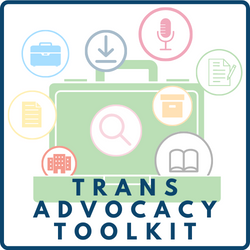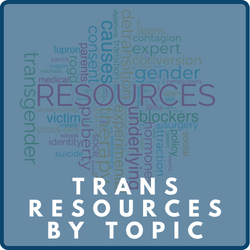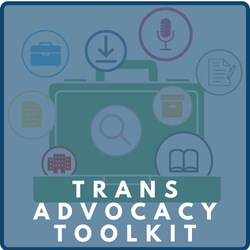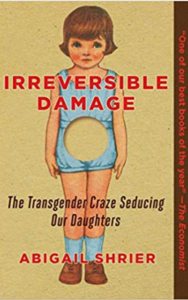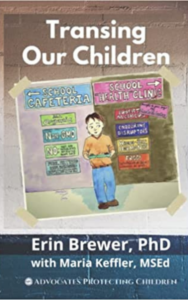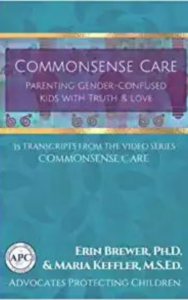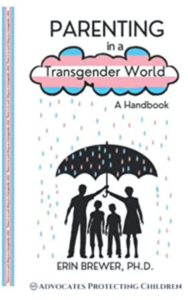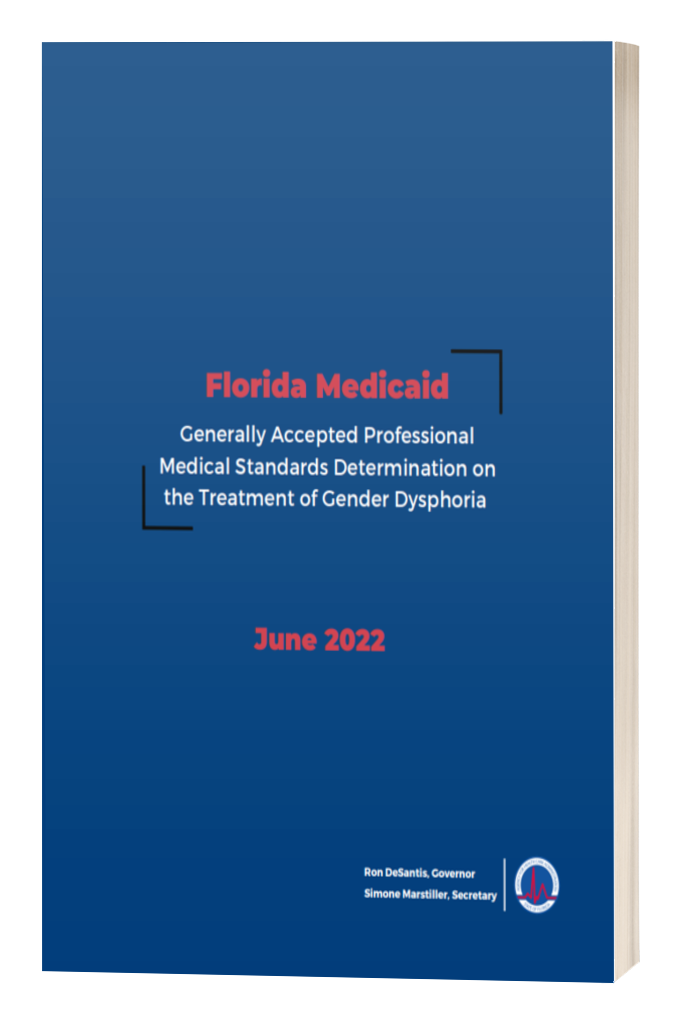UNDERSTANDING TRANSGENDER ISSUES
Resources by Topic
PUBERTY BLOCKERS | CROSS-SEX HORMONES | SURGERY | CONSENT | POTENTIAL CAUSES | ROGD | SUICIDE | SOCIAL TRANSITION | MEDICAL TRANSITION | SOCIAL CONTAGION | PARENTAL RIGHTS | POLICIES | EXPERIMENTATION | LEGISLATION | SOGI | WOMEN’S SPORTS | PUBLIC ACCOMMODATIONS | BIRTH CERTIFICATES | INTERSEX/DSD | COMPELLED SPEECH | AFFIRMATION | GENDER DYSPHORIA | DESISTERS/DETRANSITIONERS | THERAPY BANS
Cross-Sex Hormones
Books
Videos
Gender Dysphoria in Children: A Cry for Help Not Hormones
The Boyce of Reason
Commonsense Care
Dysphoric
Medical Harms from the Treatment of Child and Adolescent Gender Dysphoria
HB1057 Senate Committee Hearing – Vulnerable Child Protection Act
My experience with PLANNED PARENTHOOD
NHS child gender clinic: Staff welfare concerns ‘shut down’ – BBC Newsnight
Puberty blockers: Under-16s ‘unlikely’ to be able to give informed consent
Puberty blockers: ‘We need facts and evidence, not ideology’
The Rise of Transgender Medicine
Detransition Conference and medical ethics in the age of gender identity
ROGD Webinar
Trans Mission
Trans Train
Utah House Judiciary Committee Hearing Highlights on HB 399
Heyer – ATI 2021
Former Transgender Asks Senators Not to Ban Counselling That Helped Her Change:
Michelle Cretella
Organizations
Guides
Research
Transgender and Gender Diverse Children and Adolescents: Fact-Checking of AAP Policy
The American Academy of Pediatrics (AAP) recently published a policy statement: Ensuring comprehensive care and support for transgender and gender-diverse children and adolescents. Although almost all clinics and professional associations in the world use what’s called the watchful waiting approach to helping gender diverse (GD) children, the AAP statement instead rejected that consensus, endorsing gender affirmation as the only acceptable approach. Remarkably, not only did the AAP statement fail to include any of the actual outcomes literature on such cases, but it also misrepresented the contents of its citations, which repeatedly said the very opposite of what AAP attributed to them.
Occurrence of Acute Cardiovascular Events in Transgender Individuals Receiving Hormone Therapy
In hypogonadal/postmenopausal individuals, hormone therapy has been associated with an increased risk for cardiovascular events (CVEs). A steeply growing population that often receives exogenous hormones is transgender individuals. Although transgender individuals hypothetically have an increased risk of CVEs, there is little known about the occurrence of CVEs in this population.
Pelvic pain and persistent menses in transgender men
Pelvic pain in transgender men can be a clinical challenge and has a broad differential diagnosis. Pelvic pain less than 6 months of duration is considered acute.
Use of puberty blockers for gender dysphoria: a momentous step in the dark
We write with three areas of concern about the increasing use of puberty-blocking medication for gender dysphoria (GD) referred to in your recent leading article.
Cross-sex Hormones and Acute Cardiovascular Events in Transgender Persons: A Cohort Study
Venous thromboembolism (VTE), ischemic stroke, and myocardial infarction in transgender persons may be related to hormone use.
Evidence for an altered sex ratio in clinic-referred adolescents with gender dysphoria
Sociological and sociocultural explanations are offered to account for this recent inversion in the sex ratio of adolescents with gender dysphoria.
The Tavistock’s Experiment with Puberty Blockers
The Dutch protocol promised to create a more passable simulacrum of the opposite sex than could be achieved by physical intervention in adulthood. It was therefore embraced by trans-identified children and their parents, by older transgender activists, and by some clinicians specializing in gender dysphoria. The Gender Identity Development Service (GIDS), part of the Tavistock and Portman NHS Foundation Trust, treats children with gender dysphoria from England, Wales, and Northern Ireland. It launched an experimental study of “puberty blockers”—the more friendly term for GnRHa when administered to children with gender dysphoria—in 2011. The experiment gave triptorelin to 44 children, which in all or almost all cases led eventually to cross-sex hormones. This paper describes the origins and conduct of this study and scrutinizes the evidence on its outcomes.
Puberty Blockers and Suicidality in Adolescents Suffering from Gender Dysphoria
According to Turban, King, Carswell, and Keuroghlian (2020), suicidal ideation is lower in transgender adults who as adolescents had been prescribed “puberty blockers”—gonadotropin-releasing hormone analogs (GnRHa). This finding was derived from a large nonrepresentative survey of transgender adults in the U.S., which included 89 respondents who reported taking puberty blockers. Turban et al. (2020) tested six measures of suicidality and three other measures of mental health and substance abuse. With multivariate analysis, only one of these nine measures yielded a statistically significant association: the respondents who reported taking puberty blockers were less likely to have thought about killing themselves than were the respondents who reported wanting blockers but not obtaining them. This finding was widely reported in the media; the lead author published a column on its implications for health policy in the New York Times (Turban, 2020).
Given that puberty suppression left up to a third of patients with abnormally low bone density, Joseph et al.’s recommendations are surprisingly complacent. One is to reduce DXA monitoring which ‘can have significant financial implications for healthcare providers’. Another is to change the computation of Z-scores; ‘reference ranges may need to be re-defined for this select patient cohort’. Rather than altering a measure that provides inconvenient findings, practitioners of puberty suppression must record fractures as adverse events.
Puberty Blockers and Suicidality in Adolescents Suffering from Gender Dysphoria
Turban et al. (2020) contributed nothing to our knowledge of the effects of suppressing puberty in adolescents.
Correction to Bränström and Pachankis
After the article “Reduction in Mental Health Treatment Utilization Among Transgender Individuals After Gender-Affirming Surgeries: A Total Population Study” by Richard Bränström, Ph.D., and John E. Pachankis, Ph.D. (doi: 10.1176/appi.ajp.2019.19010080), was published online on October 4, 2019, some letters containing questions on the statistical methodology employed in the study led the Journal to seek statistical consultations. The results of these consultations were presented to the study authors, who concurred with many of the points raised. Upon request, the authors reanalyzed the data to compare outcomes between individuals diagnosed with gender incongruence who had received gender-affirming surgical treatments and those diagnosed with gender incongruence who had not. While this comparison was performed retrospectively and was not part of the original research question given that several other factors may differ between the groups, the results demonstrated no advantage of surgery in relation to subsequent mood or anxiety disorder-related health care visits or prescriptions or hospitalizations following suicide attempts in that comparison.
The Right to Best Care for Children Does Not Include the Right to Medical Transition
Refuting that any child has the right to medically transition
Debate: Different strokes for different folks
A gender social transition in prepubertal children is a form of psychosocial treatment that aims to reduce gender dysphoria, but with the likely consequence of subsequent (lifelong) biomedical treatments as well (gender-affirming hormonal treatment and surgery).
Puberty Blockers, Cross-Sex Hormones, and Youth Suicide
Lowering legal barriers to make it easier for minors to undergo cross-sex medical interventions without parental consent does not reduce suicide rates—in fact, it likely leads to higher rates of suicide among young people in states that adopt these changes. States should instead adopt parental bills of rights that affirm the fact that parents have primary responsibility for their children’s education and health, and that require school officials and health professionals to receive permission from parents before administering health services, including medication and “gender-affirming” counseling, to children under 18. States should also tighten the criteria for receiving cross-sex treatments, including raising the minimum eligibility age.
Gender dysphoria in young people: The Interim Cass Review and its implications for nursing
The aim of this editorial was to explore the implications for nurses of the initial published findings of the English ‘Independent review of gender identity services for children and young people’. The Review, led by paediatrician Dr Hilary Cass, was commissioned by NHS England. Its aim is to make recommendations on clinical management and service provision to ensure that the best model(s) for safe and effective services for children and young people who experience gender incongruence or gender-related distress are commissioned. The Interim Report was published in February 2022 (Cass, 2022) and represents the work of the Review to date. This work was instigated against a backdrop of growing international concern about the recent and very rapid growth in the numbers of children and young people presenting with gender dysphoria and how best to support them. Of particular concern has been the current model for care and role of medical and surgical intervention. Whilst findings and recommendations will only relate to England, they are likely to inform international opinion and reverberate well beyond that country.
Two Dutch studies formed the foundation and the best available evidence for the practice of youth medical gender transition. We demonstrate that this work is methodologically flawed and should have never been used in medical settings as justification to scale this “innovative clinical practice.” Three methodological biases undermine the research: (1) subject selection assured that only the most successful cases were included in the results; (2) the finding that “resolution of gender dysphoria” was due to the reversal of the questionnaire employed; (3) concomitant psychotherapy made it impossible to separate the effects of this intervention from those of hormones and surgery. We discuss the significant risk of harm that the Dutch research exposed, as well as the lack of applicability of the Dutch protocol to the currently escalating incidence of adolescent-onset, non-binary, psychiatrically challenged youth, who are preponderantly natal females. “Spin” problems—the tendency to present weak or negative results as certain and positive—continue to plague reports that originate from clinics that are actively administering hormonal and surgical interventions to youth. It is time for gender medicine to pay attention to the published objective systematic reviews and to the outcome uncertainties and definable potential harms to these vulnerable youth.
Gender dysphoria in young people: The Interim Cass Review and its implications for nursing
The aim of this editorial was to explore the implications for nurses of the initial published findings of the English ‘Independent review of gender identity services for children and young people’. The Review, led by paediatrician Dr Hilary Cass, was commissioned by NHS England. Its aim is to make recommendations on clinical management and service provision to ensure that the best model(s) for safe and effective services for children and young people who experience gender incongruence or gender-related distress are commissioned. The Interim Report was published in February 2022 (Cass, 2022) and represents the work of the Review to date. This work was instigated against a backdrop of growing international concern about the recent and very rapid growth in the numbers of children and young people presenting with gender dysphoria and how best to support them. Of particular concern has been the current model for care and role of medical and surgical intervention. Whilst findings and recommendations will only relate to England, they are likely to inform international opinion and reverberate well beyond that country.
Two Dutch studies formed the foundation and the best available evidence for the practice of youth medical gender transition. We demonstrate that this work is methodologically flawed and should have never been used in medical settings as justification to scale this “innovative clinical practice.” Three methodological biases undermine the research: (1) subject selection assured that only the most successful cases were included in the results; (2) the finding that “resolution of gender dysphoria” was due to the reversal of the questionnaire employed; (3) concomitant psychotherapy made it impossible to separate the effects of this intervention from those of hormones and surgery. We discuss the significant risk of harm that the Dutch research exposed, as well as the lack of applicability of the Dutch protocol to the currently escalating incidence of adolescent-onset, non-binary, psychiatrically challenged youth, who are preponderantly natal females. “Spin” problems—the tendency to present weak or negative results as certain and positive—continue to plague reports that originate from clinics that are actively administering hormonal and surgical interventions to youth. It is time for gender medicine to pay attention to the published objective systematic reviews and to the outcome uncertainties and definable potential harms to these vulnerable youth.
There are no laboratory, imaging, or other objective tests to diagnose a “true transgender” child. Children with GD will outgrow this condition in 61% to 98% of cases by adulthood. There is currently no way to predict who will desist and who will remain dysphoric. The degree to which GAT has contributed to the rapidly increasing prevalence of GD in children is unknown. The recent phenomenon of teenage girls suddenly developing GD (rapid onset GD) without prior history through social contagion is particularly concerning .




